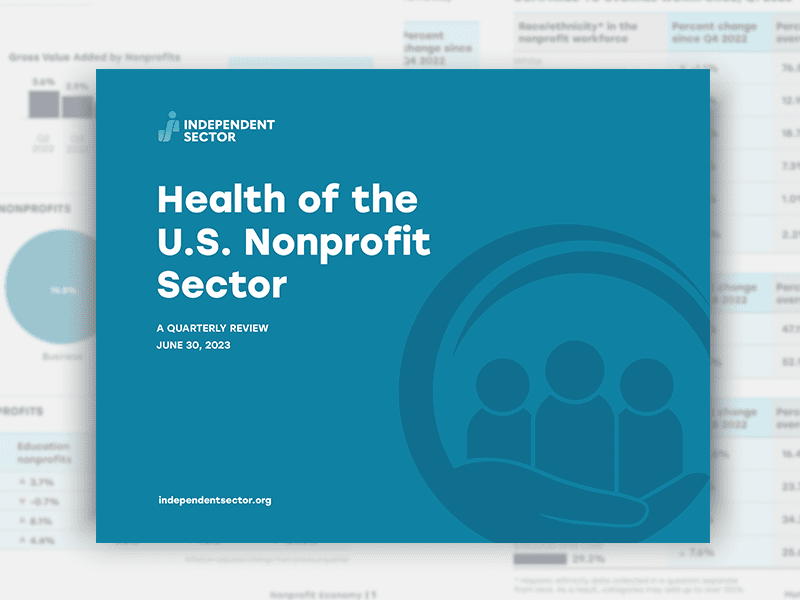Nonprofits in the United States are surviving but not thriving, according to Independent Sector’s 2023 Health of the U.S. Nonprofit Sector: Annual Review. The just-released report provides a high-level snapshot of the current state of nonprofit organizations in the country across a wide range of indicators, illustrating how donor behavior, workforce mental health, public trust, and advocacy are inextricably tied together.
Nonprofits continue to raise money, manage volunteers, and reliably provide life-saving services to their communities. Unfortunately, many provide these functions in resource-constrained, highly stressed environments with less community support than in the past. Consequently, even though nonprofits by nature are scrappy and resilient, their health data indicates they are in survival mode and will not be able to continue providing essential services into the future without systemic changes that help them shift from surviving to thriving.
“Survival” cannot be the endgame for nonprofits. In the public health field, experts agree that addressing survival rates is not sufficient to improve overall health metrics, so they developed new goals that integrate the social factors in people’s environments that affect whether they survive or thrive. Interestingly – but not surprisingly for those who know our sector – many of the key social determinants of health for individuals rely on healthy nonprofit institutions to ensure their economic stability, help them vote, and connect them to others through volunteering and giving. In other words, the health of U.S. residents depends on the health of nonprofits. It is incumbent upon nonprofit and policy leaders to identify and improve those variables that not only help nonprofits keep their doors open today, but also ensure they have reliable staff, volunteers, and donors in the future.
This 2023 health report includes a range of important indicators, and these are our top takeaways:
- Social Capital Is at Risk: Declining public trust and civic participation (e.g., donations, volunteerism, and voting) combined with individuals’ negative economic outlooks signals the social glue that holds communities together could be at risk.
- Workers Lack Adequate Support: Inadequate financial and social supports, particularly regarding caregiving responsibilities for women, may be contributing to high rates of burnout and a reluctance to accept new positions within the nonprofit sector – challenges that require systemic solutions.
- Nonprofits Opt Out of Systemic Solutions: Despite the need for systemic changes, a significantly smaller proportion of nonprofits advocate or lobby for those changes today, compared to 2000, making it more difficult to successfully address the major issues undermining the health of U.S. nonprofits.
Social Capital Is at Risk
A range of nonprofit research, including several Independent Sector health reports, notes concerning declines in donor and volunteer rates. The declines indicate the public may be disengaging from nonprofit institutions long celebrated as places to build the bonds (i.e., social capital) that bring diverse people together.
This trend is even more concerning in light of four years of findings from Independent Sector’s Trust in Civil Society reports. These reports show public trust in the nonprofit sector is declining, with this year’s decline outpacing that of any other institution, including the federal government. The less people interact with nonprofits, the less likely they are to trust them. We also see drops in trust in – and engagement with – nonprofits when people report high levels of uncertainty about their financial futures. As individual economic uncertainty rises, engagement with nonprofits seems to decrease – and critical social bonds that can help sustain individuals through hard times diminish.
This drop in public trust aligns with social capital research that asserts people’s trust falls as communities become more diverse. This is particularly true when people do not have the space or ability to form relationships that bridge across economic, geographic, gender, or racial divides. Communities with low levels of “bridging” social capital are susceptible to extreme partisanship, government dysfunction, higher crime, fewer women on corporate boards, and lower economic mobility. Conservative Tim Carney’s analysis found that a feeling of alienation due to a lack of social capital in struggling, working class communities contributed to the current polarized political environment. Frequently proposed solutions include increasing affordable child care, reducing the cost of higher education, and encouraging voting, volunteering, and national service. Regardless of the proposed solutions, conservatives and progressives agree across four areas:
- social capital appears to be declining;
- a lack of social capital is at least partly to blame for political polarization;
- social capital is intertwined with individuals’ financial security; and
- the solution is to strengthen institutions that can help bring communities back together.
Given the very clear contribution nonprofits make to knit communities together and keep them moving forward through even the hardest times, political and business leaders would be wise to look to our sector for insights about how to best rebuild social capital in the future.
Nonprofit Workers Lack Adequate Support
Front-line nonprofit employees work tirelessly to support their communities, but they lack adequate support for themselves and their families. A comparative analysis of nonprofit employee data spanning 2019 through 2023 shows nonprofit workers below the median income level bore the brunt of the negative impacts of COVID-19. A separate United Way analysis shows 20% of nonprofit workers struggle to afford necessities. Therefore, a large portion of nonprofit employees face significant, sustained stress beyond their workloads. In 2022, nonprofits also reported difficulties funding and recruiting volunteer labor, which researchers warned could lead to increased burnout among paid staff.
Nonprofits have some of the largest pay disparities for women and employees of color compared to other sectors. For women, the greatest disparities are often observed for mothers of young children. An Urban Institute study found that the invisible labor mothers conduct outside of work costs each of them almost $300K in earned wages over their lifetimes. During the pandemic, more moms left the workforce than dads and, like the nonprofit sector, didn’t recover to pre-pandemic employment levels until fall 2022 (a year after men). Across sectors, mothers with low levels of education had greater employment losses and a slower recovery. These trends correlate with broad nonprofit sector trends regarding the impact of COVID-19, which indicate that the challenges women across sectors face likely impact the overall nonprofit workforce due to its high proportion of female employees. DOL cites a lack of care infrastructure to explain why women are more likely to leave the workforce and return more slowly, which may be causing or exacerbating worker shortage complaints from employers across sectors.
In the movie “Fair Play,” sociologist Caitlyn Collins says, “Women’s work/family conflict, stress, exhaustion, and burnout [is] not new, and it also is not something they can fix all by themselves.” It’s also not a problem individual nonprofit employers can address alone. The daily stress lower-paid and female nonprofit workers experience outside of their 9-to-5 positions negatively impacts their life expectancy, their families’ well-being, their nonprofit employers’ ability to advance missions, and even overall economic productivity. Building a strong, national caregiving infrastructure and paid leave protections are two frequently cited systemic solutions, along with establishing affordable housing, accessible transportation, and improved healthcare. Updating overtime rules also could make a tangible difference for overwhelmed, lower-wage nonprofit workers. However, the additional financial burden updated regulations may place on nonprofits further illustrates why improving workforce conditions requires a continuum of systemic changes to support not only nonprofits but also the broader community in which they operate.
Nonprofits Opt Out of Systemic Solutions
Many of the institutional “health” challenges being faced by nonprofits, their missions, their workers, and their constituents can only be solved with difficult systemic change. Those changes do not happen on their own – they require good public policy and advocacy. Unfortunately, the sector’s knowledge of, and participation in, advocating for systemic change is declining at the same time its action is urgently needed.
A significantly smaller percentage of nonprofits advocate or lobby today compared to 20 years ago. They also are less knowledgeable about what types of advocacy and lobbying actions they are legally allowed to take compared to 2000. Low participation rates persist even when research shows organizations would directly benefit from policy change. Although research emphasizes the importance of voter participation to improve social capital and indicates that nonprofits are uniquely effective in helping people vote, only 13% of organizations report engaging in nonpartisan election work. Research also shows a universal charitable deduction could increase both donor participation and amounts donated to nonprofits, but organizations most reliant on individual donations are less likely than other nonprofits to advocate.
Anecdotally, when asked why they choose not to advocate, many nonprofits cite concerns about offending volunteers, donors, funders, or constituents with policy positions. However, a public poll confirms a majority of the public (90%) is supportive of nonprofits educating policymakers (i.e., advocacy). In fact, voters say they are more likely to donate to a nonprofit if it advocates on issues that impact their community (66%) or helps people in their community vote (54%).
As we come to the close of 2023, it is clear the health of U.S. nonprofits and civil society is in a precarious state. While nonprofits are understandably preoccupied fighting for survival, systemic challenges such as those mentioned previously continue to mount. We are left with the question of whether our sector simply “survives,” or if there is a path to thriving for nonprofits and the communities we engage and serve. This is a path that will require the knowledge, motivation, and resources necessary to drive systemic change.
This Independent Sector report reinforces just how steep that path is – but it is not insurmountable. Nonprofits can take action today by joining existing efforts to increase donor participation, increase voting and volunteerism, and improve caregiving and compensation for nonprofit workers.



